Simrad Broadband Radar 4G, hand's-on #1
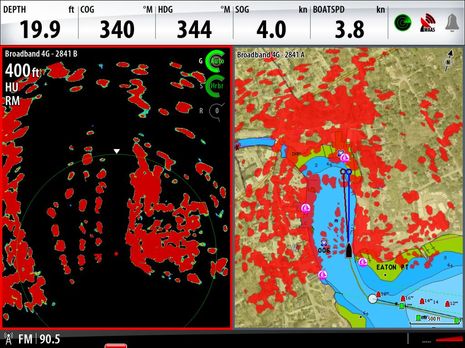
I've looked forward to testing Simrad's new 4G Broadband Radar since I saw it demoed in Fort Lauderdale. And how timely that I got out with it and the rest of Gizmo's test radars over the weekend. Tonight I'm reprising my Seven Sea's University radar webinar, and now I've got fresh material! (No hard sell meant, but Panbo readers can get the SSCA discount by using the code "Gizmo" and note that you can watch the webinar any time in the next few weeks if you can't make it tonight). Plus it's been weirdly warm here for early December, so I had a pleasant cruise even if almost all those finely targeted Camden Inner Harbor floats are empty in anticipation of what is surely coming...
Whereas a lot of readers are anxious for a 4G report, I'll start with a summary (but please bear in mind that testing and comparing radars is tricky business). In my view, 4G truly is a significant upgrade from the original BR24 and its 3G successor. It does have more power, better range, and better horizontal resolution. Higher possible automated rotation speed will no doubt improve close-in tracking of fast targets (I only got one lobster boat to test that theory on), and the new dual range feature -- if you have an MFD that supports it -- is the absolute bomb. But can it faithfully produce the range of a 4kw radome or the beam width of a 3.5-foot open array? Is it true that "Broadband 4G Radar signals the death of pulse" radar? Sorry, but that kind of talk is premature, I think.
Not that 4G didn't impress me mightily. Click on that top screen for the highest detail of Camden Inner Harbor, both in range resolution and horizontal resolution, that I've ever seen from a radar antenna 24-inch or less. And note that the radar overlaid over the chart window is operating at a greater range with completely independent controls, something I've never seen before even though the Furuno DRS2D, last discussed here in June, and the Raymarine RD418HD can both do dual range...
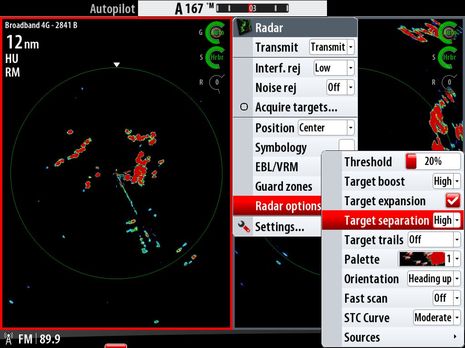
Above is a look at 4G set to 12 mile range with Gizmo off Camden and headed South toward Owl's Head. You can also see the controls available to get the most out of the "B" side of the 4G (it really is like having two 4G radars at work). I have Target boost on "high", Target expansion enabled, and the threshold for weak signals turned down fairly low, all of which should help with distant targets, I think. And there are more distant targets than shown, even if they are radar-absorbing evergreen foliage on sloping terrain. The other radars, even the 2kW Furuno, showed more of the distant topography, which I'll illustrate in a coming entry.
Now out in open waters, I might use the 12 mile range or greater to check navigation against good targets like headlands and lighthouses, or to monitor vessels that might not have AIS, and 4G might do alright with the gain cranked up...
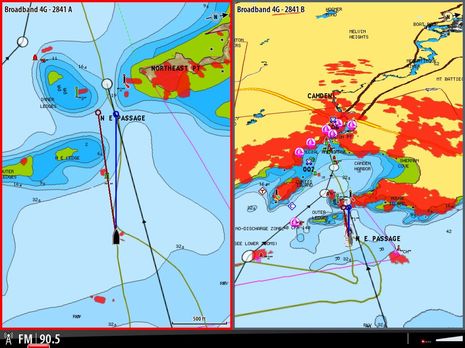
But the screen above better illustrates how I'll likely use 4G for coastal cruising, and if you appreciate overlay and maybe even 3D, it's extraordinary. Radar overlay imagery is always a bit "dumbed down" to make it show decently on a chart, but those are two completely independent overlays, and all the tweaks seen in the menu further above can be applied to each. What's also telling on that screen is that some targets are showing up behind Gizmo, despite the fact that the 4G is mounted on the front of the flying bridge with quite a lot of obstructions behind it. Super low power Broadband is sensitive to onboard obstructions, but the BR24 that used to run from the same spot never saw targets much abaft the beam. Definite power improvement. (Yes, I ought to put the 4G up on the mast to more fairly compare long range performance, but it's crowded up there, the lower mount does help with extreme near range performance, and I'd be a dite nervous to point a magnetron beam so directly at, and close to, my body.)....
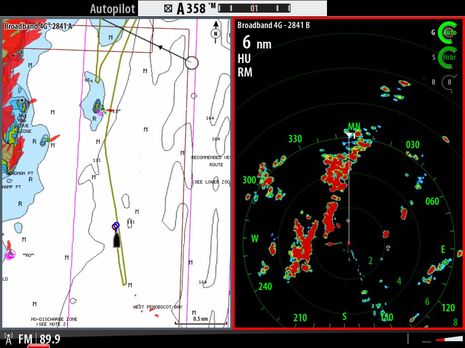
Above is another useful cruising mode, with independent close range overlay on the left and 6 mile straight radar windowed on the right. Note how the offset long range is actually seeing hills and islands at about 8 miles. I believe that's better than previous Broadbands, somewhat comparable to the good HD radomes, and that you would make out larger vessels at that range, especially in more open waters. But note also how 4G's "beam sharpening" is separating the ledge and buoy pair about a mile ahead. That's very hard to do with the 5 degree beam width typical of an 18-inch radome.
Now an important caveat. Note how the screen below, taken nearly at the same time as the one above, does not seem to have the beam sharpening in action (and does not identify A and B radars). That's because it was taken on the Simrad NSS8 which is also onboard Gizmo these days. It's a fine MFD, and better than when I first tried NSS in Spain, but it does not support the 4G dual range feature. It does show beam sharpening, which is a bit confusing on Simrad's BR comparison table, but I'd have to reduce the range on the right window for the horizontal detail to show up on the left window. (This caveat also applies to the Lowrance version of 4G.) Would a Simrad NSE with its apparently more powerful processor (and its wonderful quick mode buttons) be nice with touchscreen added? Heck, yes!
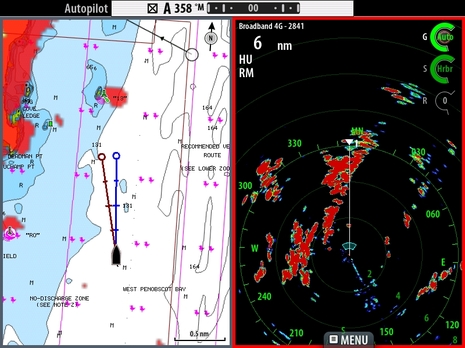

 Share
Share
I meant to add the observation that Beam Sharpening -- the 4G's unique ability to simulate the narrower beam of a longer antenna -- seems a little "jaggedy" to me. It really does work, as you can see on the next to last screen, but sometimes it appears to break up objects that aren't separate, like a few of those harbor floats on the very first screen.
When I get back to cruising I may end up putting Target Separation to medium or low on one of the two internal radars to get a smoother presentation, particularly for overlay. But, sadly, that's not going to happen until April or May. I started stripping electronics off Gizmo on Monday, convinced that I'd turn out a fool if I passed up a warm, sunny afternoon at this late date.